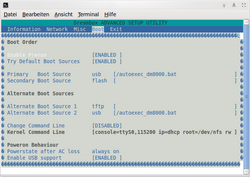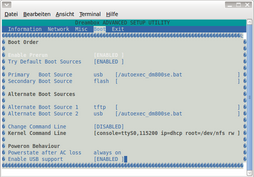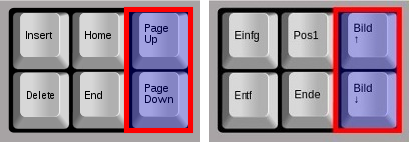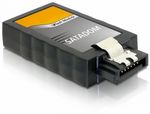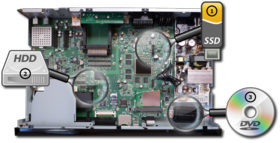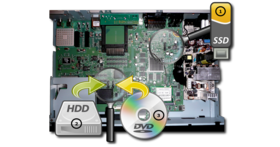MediaBoot Script (en)
InhaltsverzeichnisThe Media-Boot script by emanuel installs an image onto a media device such as USB, CF, SD or SSD, inclusive the GP3 Feed. While executing the script the device gets partitioned into 3 partitions (boot, swap and root). Subsequently the image (as tar.bz2 archive) is downloaded and unpacked onto the device. After an automatic restart of the Dreambox the image from the device is booted and offers enough memory for all your needs. Interesting e.g. for the DM800se with small flash capacity ;)
Requirements:
Bios configurationYou need to prepare the Bios to be able to boot via a removable media containing the FAT filesystem. The USB support needs to be activated for all Boxes.
DM 500 HDPrimary boot source: usb [/autoexec_dm500hd.bat] Secondary boot source: flash Enable USB support: [ENABLED]
DM 800HD sePrimary boot source: usb [/autoexec_dm800se.bat] Secondary boot source: flash Enable USB support: [ENABLED]
DM 7020HDPrimary boot source: usb [/autoexec_dm7020hd.bat] Secondary boot source: flash Enable USB support: [ENABLED]
DM 8000HD PVRPrimary boot source: usb [/autoexec_dm8000.bat] Secondary boot source: flash Enable USB support: [ENABLED]
Configure Media-BootDownload the wanted script from Media-Boot Thread unpack and copy the file with FTP onto the Dreambox in the directory /home/root. Make sure the script has the correct rights, otherwise it can not be executed. Use the following command when connected via telnet or ssh. Attention this command is for the script for the DMM exp. Image. If you use the script for Merlin, you need to replace media-boot by merlin-media-boot! chmod 755 media-boot
Media-Boot ScriptInformationsInformations about Media-Boot can be displayed as follows. root@dm800se:~# ./media-boot --help
media-boot: is a script to install dreambox image (OE2) on extern device >= 1GB
NOTE: this script is only for advanced users!
Make sure the selected device is not your harddisk!!
Usage: media-boot -i /dev/sd<a-z>
install image on selected device /dev/sd<a-z>
Usage: media-boot -d
shows avaible devices on box
root@dm800se:~#
List the available media devicesWith the following command you can list the available devices. In the example (output reduced) a hard disk and a USB Stick with 8GB is found. The name of the device is important for starting the Media-Boot script in the next step. In this example the USB Stick has the name /dev/sdb. root@dm800se:~# ./media-boot -d media-boot: found following devices on box: Disk /dev/sda: 500.1 GB, 500107862016 bytes 255 heads, 63 sectors/track, 60801 cylinders Units = cylinders of 16065 * 512 = 8225280 bytes Device Boot Start End Blocks Id System /dev/sda1 1 60801 488384028+ 83 Linux Disk /dev/sdb: 8006 MB, 8006926336 bytes 84 heads, 6 sectors/track, 31028 cylinders Units = cylinders of 504 * 512 = 258048 bytes Device Boot Start End Blocks Id System /dev/sdb1 5 31025 7817216 b Win95 FAT32
Execute Media-BootMedia-Boot is started with the following command. Make sure you use the correct device name, pay attention you don't make a mistake and specify your hard disk. Be patient, the initializing, downloading and unpacking of the image takes a while. Afterwards the box restarts automatically, and the image from the stick is booted. You can check the available memory with df -h. root@dm800se:~# ./media-boot -i /dev/sdb media-boot: installing on device: /dev/sdb media-boot: stoping automount reboot to get back media-boot: stoping udev . . .
Install ChkbootmediaAfter booting the Dreambox successfully from the media device the additional package (chkbootmedia_x.xx_all.ipk) needs to be installed. This is needed to prevent overwriting the autoexec_*.bat when kernel updates are installed. This would lead to a failed boot of the media device. Download the package from here and copy the file with FTP onto the Dreambox in the directory /tmp. Install the package with the following commmand. opkg install /tmp/chkbootmedia*
Backup / Restore ImageYou can create or restore a backup with the following commands. The example uses again the media device /dev/sdb. The name of the media device can be found with the command fdisk -l. Backup ImageWhen the image is running from the media device you can make a backup with the dd command. In this example the path for the backup refers to the hard disk and the file name is my_backup.img. The size of the backups is the same size as the used media device. The process takes a while, please be patient and wait until the command line shows a prompt again. dd if=/dev/sdb of=/media/hdd/my_backup.img
Restore ImageStart the Dreambox from Flash memory and use the following command for restoring. Make sure the device name is correct. Again use the command fdisk -l to double check! Make sure you use a media device which is at least the same size as the backup file (*.img). The process takes a while, please be patient and wait until the command line shows a prompt again. dd if=/media/hdd/my_backup.img of=/dev/sdb
DM8000HD with SATA SSD deviceMedia-Boot can also install the Image onto a SATA SSD device. Advantage: the Image can boot very fast from this medium. As device you can use e.g. the DeLOCK SATA 2GB Flash Module (vertical). The device fits (in height) perfectly in the DM 8000HD PVR and can be connected to the power supply of the Dreambox with the delivered cable. The BIOS of the Dreambox must also be changed for the SATA SDD device. but not as described in the article. The Dreambox only boots from a SATA device, when the Kernel Command Line is activated and set correctly. Keep in mind you can only boot from Flash, when the Kernel Command Line is deactivated again. Otherwise the Image from the SSD device will still be booted. Also important to know: the Dreambox can actually not boot directly from SATA, but only from USB. With this setup the Flashkernel boots and subsequently the forced Kernel command line will load the root partition from the SSD device. Therefore it's extremely important to have the same image in Flash as on the SSD device. And of course make sure to update both Images - in Flash and on the SSD - when a kernelupdate occurs.
Connect SATA SSD DeviceUse both pictures when connecting the SSD device.
Adapting the BIOSThis section shows the BIOS adjustments for Dreamboxes. In the BIOS you activate the Change Command Line (enabled) and change the Kernel Command Linie as described. For root=/dev/sdX3 the X should be replaced with the correct character. Use the media-boot script or the command fdisk -l, to find out the SSD device. Change Command Line [ENABLED ] Kernel Command Line [console=ttyS0,115200 root=/dev/sdX3 rootfstype=ext4 rw]
Execute Media-BootStart the Media-Boot Script as described before. The package Chkbootmedia is not needed, because the autoexec_.bat is not read.
Tips & TricksInstall the GP3.2 PluginThe script offers the possibility to install the GP3.2 Plugin, GP3 Addons or GP3-Skins. This way the BluePanel and the additional plugins and Skins are available immediately after booting the media device. Edit the script and search the following lines: EXTRA="" #EXTRA="geminiplugin geminidreamnetcast geminijukebox geminirezapp geminigweather gemininetcastwebif geminirssreader geminiwebcam" You should add the wanted packages at EXTRA="" between the quotes. The line for installing the GP3.2 Plugin, NFS Server and Gemini Jukebox looks like the following example. EXTRA="geminiplugin gemininfs geminijukebox" If you don't know the package name you can list the name when using an image with the GP3 Plugin using the following command. But before using the command do opkg update. The first command shows all GP3 packages, the second only the GP3 Skins. opkg list *gemini* opkg list *gp-skin*
Support threadIf you need help with Media-Boot, follow the Link ;)
|
